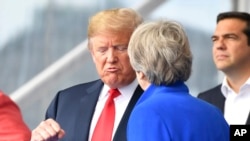In Brussels for the NATO summit, President Donald Trump continues to falsely suggest that members of the alliance owe money to the U.S. and the mutual-defense organization.
Meeting with NATO Secretary-General Jens Stoltenberg on Wednesday, Trump said: “Many countries are not paying what they should. And, frankly, many countries owe us a tremendous amount of money for many years back, where they’re delinquent, as far as I’m concerned, because the United States has had to pay for them. So if you go back 10 or 20 years, you’ll just add it all up. It’s massive amounts of money is owed.”
His comments followed a Tuesday tweet: “Many countries in NATO, which we are expected to defend, are not only short of their current commitment of 2% (which is low), but are also delinquent for many years in payments that have not been made. Will they reimburse the U.S.?”
THE FACTS: There is no such debt to the U.S. or to NATO. Therefore, no delinquency or question of payment.
In 2014, before Trump was president, NATO members agreed to stop cutting their military budgets and set a goal of moving “toward” spending 2 percent of their gross domestic product on their own defense — by 2024. It was not a “commitment,” not a direct contribution to NATO, not a payment owed to the U.S., and not something that alliance members pledged to achieve immediately.
Trump is right that most NATO members are spending less than 2 percent of their GDP on their defense budget, though more are moving in that direction.
Trump has assailed NATO members such as Germany for lagging on their military budgets while he has simultaneously taken credit for progress on that front. He has repeatedly claimed that because of his pressure, “billions and billions of dollars are pouring in,” which is also not true, because there is no such fund for money to pour into.
It’s true the U.S. is “expected to defend” fellow NATO members when they are threatened. It’s equally the case that NATO partners are expected to defend the U.S. if threatened. Article 5, the collective defense portion of the North Atlantic Treaty has been invoked just once — following the attacks of September 11, 2001.
U.S. spending constitutes well over a majority of the alliance’s overall spending on defense, which NATO acknowledges results in an “over-reliance” on the U.S. for capabilities like intelligence and aerial refueling. Previous U.S. leaders have also called on NATO members to boost their defense spending to minimize the imbalance.
NATO does have a shared budget to which each member makes contributions based on the size of its economy. The United States, with the biggest economy, pays the biggest share — 22.1 percent. Four European members — Germany, France, Britain and Italy — combined pay 43.8 percent of the total. The smaller countries pay smaller shares. The funds, totaling about $3 billion this year, are used to run NATO’s headquarters and to pay certain other civilian and military costs. No member is known to be in arrears.






